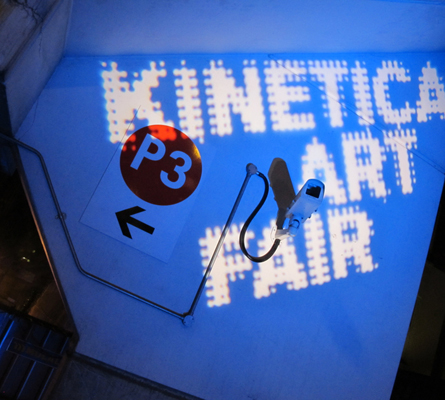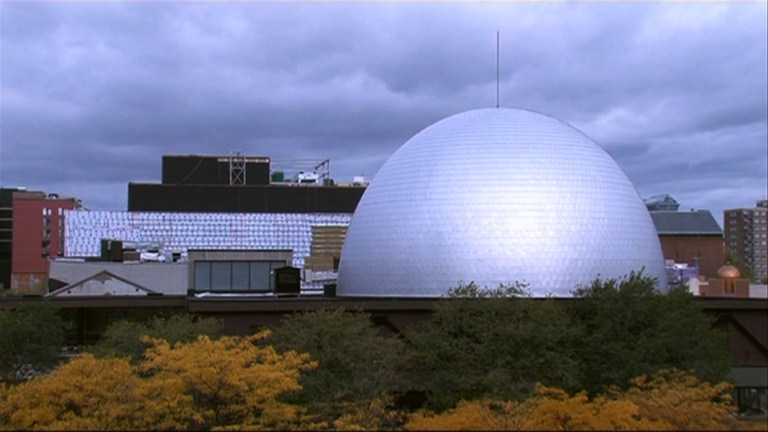 Allow me, for a moment, to add an exhibit to Naina’s post last week about the “Exhibits on our Wish List” here at Tech in the Arts. This one, however, is a little different. Combining stunning artwork with the latest in technological trends, the focus here is on art from a wide variety of interesting fields: artists who focus on kinetic, robotic, electronic, sound, light time-based and multi-disciplinary new media art and technology.
Now in its fourth year, the Kinetica Art Fair, produced by the Kinetica Museum in London, held its 2012 fair this past weekend across the pond, bringing together artists, visitors and exhibitors from around the world in a 5-day event. In addition to the art show, the fair also held presentations, live performances, screenings, panels and an awards show. With over 50 exhibitors in place and over 300 works of art, if it sounds like the world’s coolest and nerdiest art show, it just might be.
Allow me, for a moment, to add an exhibit to Naina’s post last week about the “Exhibits on our Wish List” here at Tech in the Arts. This one, however, is a little different. Combining stunning artwork with the latest in technological trends, the focus here is on art from a wide variety of interesting fields: artists who focus on kinetic, robotic, electronic, sound, light time-based and multi-disciplinary new media art and technology.
Now in its fourth year, the Kinetica Art Fair, produced by the Kinetica Museum in London, held its 2012 fair this past weekend across the pond, bringing together artists, visitors and exhibitors from around the world in a 5-day event. In addition to the art show, the fair also held presentations, live performances, screenings, panels and an awards show. With over 50 exhibitors in place and over 300 works of art, if it sounds like the world’s coolest and nerdiest art show, it just might be.
The theme of this year’s show helps solidify that opinion: titled “Time, Transformation and Energy,” the show will focus on what the organizers call “the shifting of time in the light of cosmological, astronomical, environmental and evolving universal events.” The feature exhibition of the show, centered on this theme, brings together 18 artists from eight countries, which use and display pulsating sound performances, incredible light shows, kinetic energy showcases, and, perhaps best of all, it includes robots.
What’s unique about the show from my perspective is how it uses time and the evolution of technology to advance new styles of art and expression. The founders of the event, Dianne Harris and Tony Langford, recently gave an interview to the Huffington Post where they talked about what makes the show so unique:
“Kinetica ultimately focuses on a current new trend in art that has a strong historical lineage dating back to the '50s. The work essentially makes suggestions and contributions towards human evolution and reaction to scientific and universal exploration. With the ever-increasing scientific and technological advancements in our culture, many contemporary artists have crossed the threshold from 'fine art disciplines' into new media, with artworks that utilize technology to explore, nurture and comment on our evolutionary processes.”
Another interesting facet of the show is how strongly science is interwoven into its DNA. With exhibits and presentations such as “Contemporary Conditions of Temporality in Kinetic Art” and “Architecture, Digital Media and the Kinesthetic Idea,” the show seeks to provide a scientific and theoretical background to some of the artwork on display.
Even the field of astronomy is a part of the fair as well: artist Paul Malone headlines the “Electric Universe” exhibit where he examines the role electro-dynamics play in the forming of objects that make up the world of astronomy, where visitors can hear about the history of the study of electricity.
Not to be outdone, the historical nature of the program is what appeals to me most. Who wouldn’t want to attend a presentation titled, “From Copernicus to Polish Dragons – From Physics to Poetry of Transformations”?
There are some fascinating works of art at the show as well, although none of them involve polish dragons. One of the most unique is called the Xylophone Wheel by artist Alexander Berchert, which takes the plastic clackers from bicycles and molds them together to create a musical instrument: xylophone plates are attached to the wheel and plastic beads bounce off of them, producing a distinct chime sound.
Another unique work of art, and perhaps my favorite, truly incorporates the world of social media: @TweetLamps, by artist Jordan Burnett, contains a set of light bulbs that are controlled by tweets sent through Twitter, where the lights go off when certain pre-programmed words of hashtags are tweeted.
With the 2012 fair ending yesterday (sadly), we’re a year away from the next show. For a taste of the kind of unique art you can see at the exhibit, here’s a compilation of art from their 2011 show last year:
Kinetica Art Fair 2011 from Kinetica Museum on Vimeo.
So while the 2012 show just ended, judging by pasty year’s fairs, next year’s show should be just as exciting. Anybody up for a trip to London?






